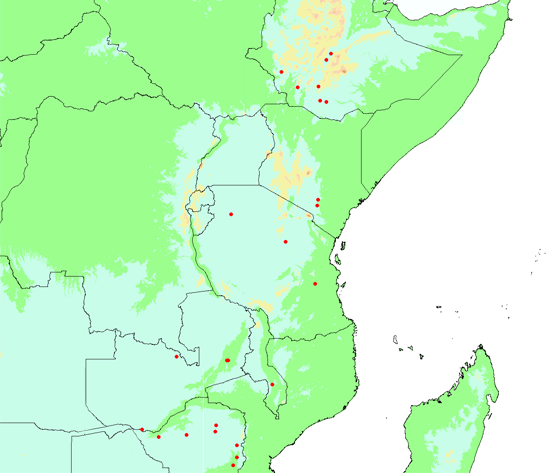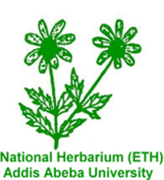Nomenclature
Ipomoea kituiensis Vatke in Linnaea 43: 511 (1882). Type: Kenya, Kitui, Hildebrandt 2759 (B holo. destroyed).
Ipomoea massaiensis Pilgerin E. J. 48: 351 (1912); T.T.C.L.: 171 (1949).
Ipomoea nykensis Hall. f. in Engl., Bot. Jahrb. 28: 53 (1899). Baker & Rendle in F.T.A. 4, 2: 196 (1906).
Ipomoea tambelensis Baker in Kew Bull. 1894: 72 (1894). Dammer in Engl., Pflanzenw Ost–Afr. C: 333 (1895).
Rivea kituiensis (Vatke) Hall. f. in Engl., Bot. Jahrb. 18: 156 (1893).
Description
Demissew, S. 2006. Convolvulaceae. In: Hedberg, I., E. Kelbessa, S. Edwards, S. Demissew and E. Persson (eds.), Flora of Ethiopia and Eritrea, vol. 5, pp. 227–231. The National Herbarium Addis Ababa University and The Department of Systematic Botany Uppsala University; Addis Ababa, Ethiopia and Uppsala, Sweden.
Gonçalves, M. L. 1987. Convolvulaceae. In: Launert, E. (ed.), Flora Zambesiaca, vol. 8, part 1, pp. 123. Flora Zambesiaca Management Committee, London.
Manos, P. S, R. E. Miller, P. Wilkin. 2001. Phylogenetic Analysis of Ipomoea, Argyreia, Stictocardia, and Turbina Suggests a Generalized Model of Morphological Evolution in Morning Glories. Systematic Botany 26(3): 585–602.
Verdcourt, B. 1963. Convolvulaceae. In: Hubbard, C.E. and E. Milne-Redhead (eds.), Flora of Tropical East Africa, pp. 144–145. Crown Agent for Overseas governments and administrations, London.
Verdcourt, B. 1967. Corrections and Additions to the 'Flora of Tropical East Africa: Convolvulaceae': I. Kew Bulletin 21(1): 83–92.
Biogeography, Ecology and Natural History

Kenya, Ethiopia, Tanzania, Malawi, Zimbabwe, Zambia
Acacia-Commiphora woodland, evergreen scrub, savanna, thickets by stream and along rivers, semi-desert country on stony hills, waste land or cultivated ground; 600–2040 m.
Number of collections seen: 23
|
months |
Jan |
Feb |
Mar |
Apr |
May |
Jun |
Jul |
Aug |
Sep |
Oct |
Nov |
Dec |
|
# flowering specimens |
4 |
2 |
1 |
1 |
2 |
5 |
||||||
|
# fruiting specimens |
1 |
2 |
1 |
4 |
Demissew, S. 2006. Convolvulaceae. In: Hedberg, I., E. Kelbessa, S. Edwards, S. Demissew and E. Persson (eds.), Flora of Ethiopia and Eritrea, vol. 5, pp. 227–231. The National Herbarium Addis Ababa University and The Department of Systematic Botany Uppsala University; Addis Ababa, Ethiopia and Uppsala, Sweden.
Gonçalves, M. L. 1987. Convolvulaceae. In: Launert, E. (ed.), Flora Zambesiaca, vol. 8, part 1, pp. 123. Flora Zambesiaca Management Committee, London.
Verdcourt, B. 1963. Convolvulaceae. In: Hubbard, C.E. and E. Milne-Redhead (eds.), Flora of Tropical East Africa, pp. 144–145. Crown Agent for Overseas governments and administrations, London.
Other information
Verdcourt (1967) suggested that I. ktuiensis, I. chrysosperma and I. spathulata form a good exampleof a super-species where the components are recognizably distinctive but thereis still a considerable interchange of genes.
Menos et al. (2001) performed a phylogenetic analysis of Ipomoeeae using the ITS region and the 3' region of the nuclear gene waxy. DNA samples of I. kituiensis (MWC8344 K) were included.
From a combined molecular and morphological analysis of 45 taxa it has been found that I. Kituiensis and I. jaegeri form a monophyletic group (subgenus Poliothamnus (Verdcourt 1963)) related with all taxa previously assigned to tribe Agryreieae, Lepistemon and six species of Ipomoea from five different sections.
Three varieties are recognised with var. kituiensis spread over the south of Ethiopia, Kenya, Tanzania, Malawi and Zimabwe; var. massaiensis restricted to Tanzania and var. hirsutissima also restricted to Tanzania. Var. kituiensis and var. massaiensis can be distinguished by their sepals that are: linear- laceolate, 10–21 x 2–4 mm in var. ktuiensis; broadly triangular to ovate, 7–10 x 4.5–6mm in var. massaiensis. Var. hirsutissima is distinguished by its hirsute sepals, leaves, stems and corolla.
Authorship for webpage



Add new comment